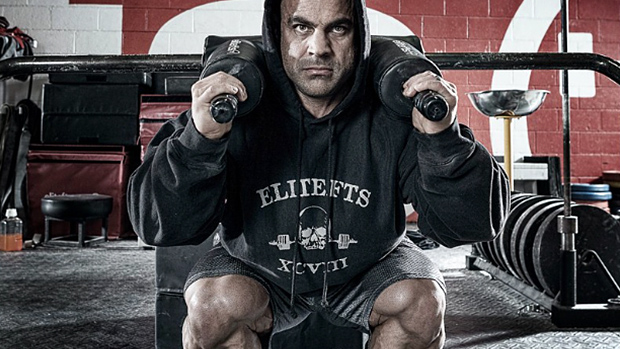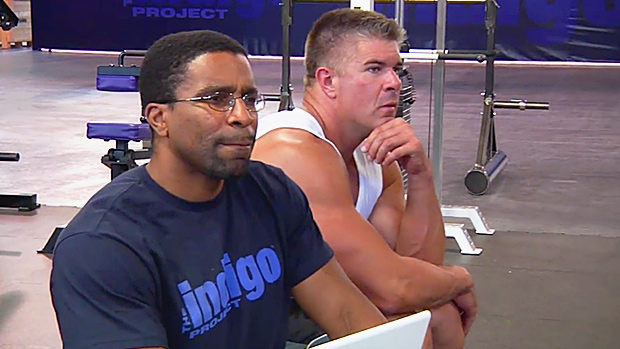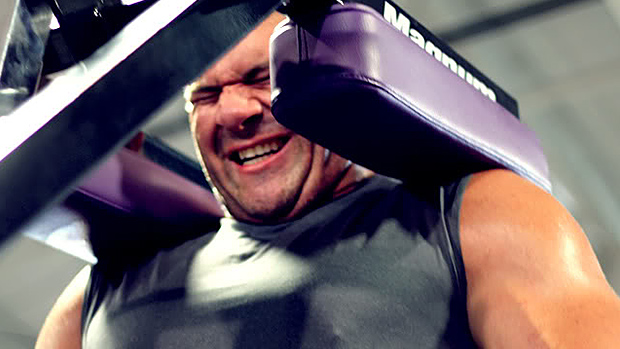The safety squat bar doesn't get the respect it deserves. It's often viewed as a piece of equipment for injured people. But it's actually one of the most valuable tools in the gym. Use it to increase your lower body strength and put size on your glutes, hamstrings, and quads. Here are a few benefits:
1 – It saves your shoulders.
If you've spent a lot of time training the bench press, squat, and overhead press, you know that the cumulative effect takes a toll on your shoulders. And while the back squat isn't an upper body exercise, locking your shoulder joints into a position to support the bar, and then creating tension to stabilize the load, causes large amounts of stress on the front and top of your shoulders.
When you lack the upper body mobility to properly set up for a back squat, your rotator cuff, labrum, and biceps tendon pay a heavy price for your lack of flexibility. And THAT can lead to injury and lost training time.
The SS bar solves this problem. It allows you to bring down your shoulders' exposure to stress, especially if you're training with high volume, and it virtually eliminates upper body mobility as a barrier of entry to higher intensity squatting. It does this while allowing you to continue benching and overhead pressing pain-free.
2 – It nails your quads.
As you continue to gain experience as a lifter, you need to make sure not to forget about quad-dominant training. The early emphasis of developing your posterior chain is great, but it needs to be balanced better with quad-dominant exercises the more advanced you get.
To target your quads, your lifts need to put you in a position with a more angled tibia, bringing your knee forward relative to your ankle. This along with a more upright torso, vertically stacking your shoulders over your hips.
Achieving this position is hard to do when you have a weight on your back. Traditionally, we've dealt with this problem using front squats, since putting the bar up front requires a more upright posture to keep you from tipping over.
The problem with the front squat is that you can't use nearly as much weight as you can when the bar is on your back. The SS bar solves this problem by splitting the difference in horizontal displacement between the front and back squat bar position, giving you the best of both worlds: an upright torso and the ability to really load up the weight.
3 – It's handy for taller lifters.
Taller lifters tend to have trouble squatting with good mechanics. Whether it's from having to control a longer spine and limbs during the lift or not having ideal leverages, the squat will always be a lift that most taller folks struggle with.
When you introduce to the SS bar to a tall lifter, he or she will unrack the bar and feel wobbly. But once settled in, the higher bar position and anterior-loaded weight will help him or her stay more upright and better positioned in the hips, spine, and upper back. And as a result, the lifter's squat will actually look like a squat and not some awful good-morning variation.
The 3 Hardest Safety Squat Bar Exercises
Let's increase the difficulty. Here are three exercises guaranteed to be the hardest exercises you'll do all week. Each one will challenge your body in a different way: single-leg strength, bilateral strength, and muscular endurance.
SS Bar Bulgarian Split Squat
If your legs are never sore after a lower body session, give these a try and you'll be feeling them the next day. Using the SS bar for Bulgarian split squats will allow you to use more weight than you could with dumbbells.
This taxes your glutes, hams, adductors, and quads through a wider range of motion than the traditional split squat. And the addition of the SS bar will demand more of your upper back and thoracic extensors to stabilize the bar on your back.
SS Bar Front Squat
This variation will smoke your quads and help those who can't do front squats with a regular barbell. The front load also forces you to have a stronger contraction of your abs and it's a great option for those who struggle to control their anterior pelvic tilt and lower back extension when squatting.
Tempo SS Bar Squat
This may be the hardest quad-dominant exercise you'll ever do. Lifters spend most of their time moving weights "fast" and getting into the hole quickly. Make yourself slow down and control the tempo of your lift, even if it means your 400-pound squat becomes a 185-pound one.
Tempo squatting stimulates hypertrophy in your slow-twitch, type-I fibers that are often neglected.
- Set up with the weight considerably lighter than you'd use for your regular squat.
- Set a timer for 40-60 seconds and keep constant tension in your lower body by pulling yourself down into the hole and not pausing at any point during the lift.
- Count 3 seconds up and 3 seconds down throughout the entire minute and you'll feel a quad burn like never before.
Strength, Mass, and a Long Lifting Career
The SS bar doesn't need to be the only piece of equipment you use, but it should be in your arsenal. It's a great way to add variety to your program and make common lower-body lifts less monotonous. Even if that's all you're looking for, you can also appreciate that the SS bar can save your lifting career by keeping your shoulders healthy while putting large amounts of strength and mass on your lower body.




